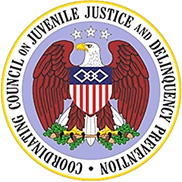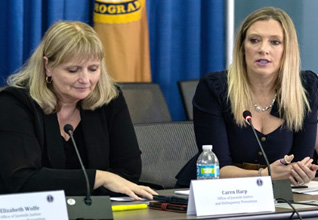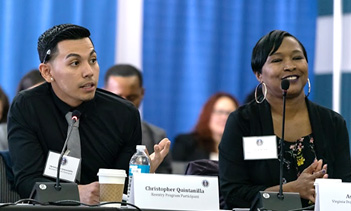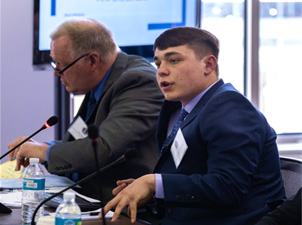
On any given day, there are more than 43,000 juvenile offenders in residential placement nationwide. Although the rate of youth incarceration has continued to decline over the past 10 years, the development of comprehensive and effective approaches for reducing recidivism remains a challenge for most state and local agencies. Youth returning to their communities after placement often require community-based services and supports in education, housing, employment, medical care, and mental health.
 Principal Deputy Assistant Attorney General Katharine T. Sullivan (right) and OJJDP Administrator Caren Harp offered remarks at the Council meeting. Ms. Sullivan is Vice Chair of President Trump’s Commission on Law Enforcement and the Administration of Justice. Quoting the President, she said, “We’re all better off when former inmates can reenter society as law-abiding, productive citizens.”
Principal Deputy Assistant Attorney General Katharine T. Sullivan (right) and OJJDP Administrator Caren Harp offered remarks at the Council meeting. Ms. Sullivan is Vice Chair of President Trump’s Commission on Law Enforcement and the Administration of Justice. Quoting the President, she said, “We’re all better off when former inmates can reenter society as law-abiding, productive citizens.”OJJDP Deputy Associate Administrator Sanzanna Dean opened the discussion of federal reentry initiatives with an overview of the Office’s Second Chance Act programs, which encourage collaboration between state agencies, local government, and community-based organizations to address the challenges that reentry poses for juvenile offenders and their families. She highlighted OJJDP’s Reentry Starts Here: A Guide for Youth in Long-Term Juvenile Corrections and Treatment Programs. The guide provides youth, family, and reentry staff with key information on how to support youth as they prepare to return to their communities upon release.
Jennifer Kemp, Director of Youth Services in the Department of Labor’s (DOL’s) Office of Workforce Investment, presented on DOL’s Reentry Employment Opportunities program, which serves youth and young adults who are currently or were previously involved in the juvenile or adult justice systems. The program offers a range of services, including tutoring, high school equivalency preparation, mentoring, occupational skills training, career counseling, job placement, and referral to other resources. Those resources include the DOL-supported American Job Center Network’s CareerOneStop, which offers information about job openings and training opportunities throughout the country. Ms. Kemp added that employers are often uncomfortable hiring people who have a criminal record. DOL’s Federal Bonding Program funds liability insurance to cover the first 6 months of employment, at no cost to the employer or job applicant. “Some people have misconceptions about people who have been involved in the justice system, that they might have liabilities,” she said. “But in the 50 years we’ve had this program, we’ve paid out less than 1 percent.”
 Christopher Quintanilla was recently released from Virginia’s Bon Air Juvenile Correctional Center. He now works as a barber and attends Northern Virginia Community College part time, majoring in organizational psychology. “I’m an aspiring psychologist and youth advocate,” he said. “When you’re transitioning [back to your community], it takes hard work and effort. . . . I like how [things] are moving forward, not getting worse.”
Christopher Quintanilla was recently released from Virginia’s Bon Air Juvenile Correctional Center. He now works as a barber and attends Northern Virginia Community College part time, majoring in organizational psychology. “I’m an aspiring psychologist and youth advocate,” he said. “When you’re transitioning [back to your community], it takes hard work and effort. . . . I like how [things] are moving forward, not getting worse.”Ashaki McNeil, Director of the Virginia Department of Juvenile Justice’s Reentry Unit, described how OJJDP’s Second Chance Act funding has helped the department build stakeholder partnerships, develop a full continuum of evidence-based services across residential and community programs, and increase family involvement in the reentry process.
Virginia’s Reentry Task Force, which meets monthly, has created memorandums of understanding that have strengthened partnerships between youth-serving agencies that provide social, behavioral health, medical, juvenile justice, and workforce development services. Community colleges are partnering with the task force to assist youth in pursuing higher education. In addition, Virginia’s Department of Juvenile Justice has increased supports and training for its staff. “It’s important to change the culture,” Ms. McNeil said. “If you treat the staff right, they treat the kids right.” The department has also added staff to coordinate family engagement activities and arranged for no-cost transportation for families to visit youth. After release, transitional housing is provided for youth who need it.
 Levi Kranz, a high school junior from Iowa, described the mentoring, life skills, psychological, and workforce development services that helped him transition back into his community. On the left is Dave Kuker, Executive Officer at the Iowa Department of Human Rights’ Division of Criminal and Juvenile Justice Planning.
Levi Kranz, a high school junior from Iowa, described the mentoring, life skills, psychological, and workforce development services that helped him transition back into his community. On the left is Dave Kuker, Executive Officer at the Iowa Department of Human Rights’ Division of Criminal and Juvenile Justice Planning.The meeting concluded with a personal testimony and recommendations from Levi Kranz, a high school junior from Sioux City with experience in an Iowa drug treatment program and two of the state’s juvenile justice residential facilities.
Levi’s life was changed by his experiences at the State Training School (STS) in Eldora, IA. There, Levi encountered mentors previously involved in the justice system who had turned their lives around. “They helped because they were really understanding,” Levi said. “I realized that I wanted to change.” STS offered vocational and recreational programming, and Levi now plans to become an apprentice in carpentry after completing high school and wants to build his own home one day. He and his mother participated in Functional Family Therapy sessions. He said that these sessions “helped me and my mom get back on the same page and communicate better.” Finally, while at STS, Levi participated in YTDM sessions. “We made all these goals, and I [saw that I] could actually do something better when I got out,” he said.
The Juvenile Justice and Delinquency Prevention Act of 1974, as amended, established the Council as an independent body to coordinate federal programs related to delinquency prevention and missing and exploited children. The Council comprises 9 ex officio members, 4 affiliate members, and 10 nonfederal practitioner members named by the President and Congress. The Attorney General is the ex officio Chair of the Council and the Administrator of OJJDP is the ex officio Vice Chair. Additional ex officio members include the Secretaries of the Departments of Health and Human Services (HHS), Labor, Education, Homeland Security, and Housing and Urban Development; the Director of the Office of National Drug Control Policy; and the Chief Executive Officer of the Corporation for National and Community Service. In addition, four affiliate federal agencies are represented on the Council: the Departments of Agriculture, Defense, and Interior, through their respective Secretaries and designees; and HHS’ Substance Abuse and Mental Health Services Administration, through its Administrator. In accordance with the Federal Advisory Committee Act, the Council holds public meetings up to four times a year in which members discuss activities to facilitate and support cross-agency coordination.
